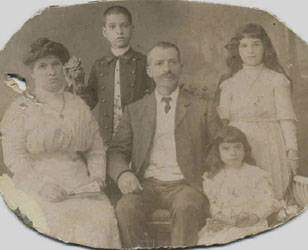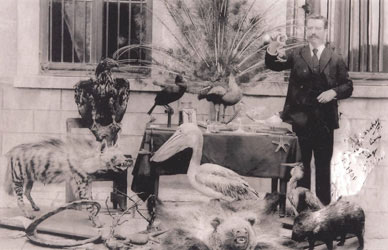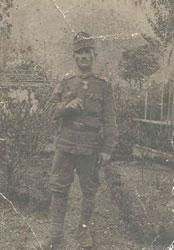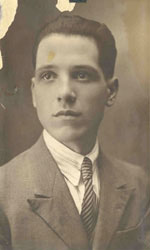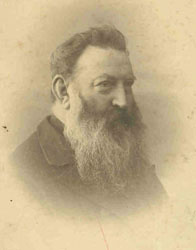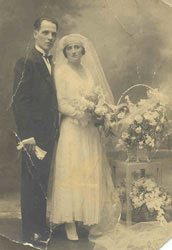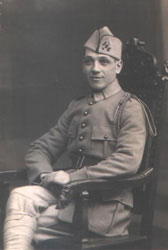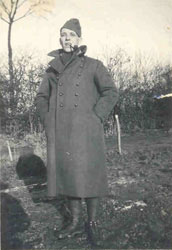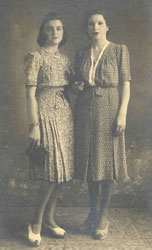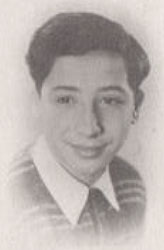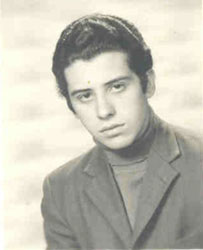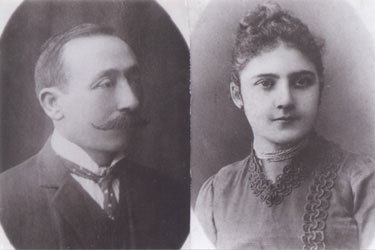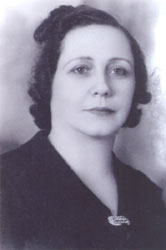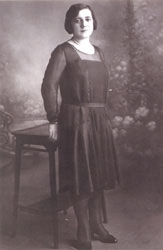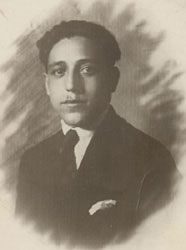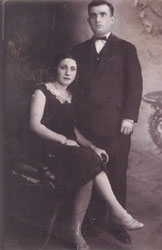My Mother’s Family
The Exarhos – Exarchos - Exarque and their Relatives with some observations on the Levantine Marriages
From the informations I got, it looks like that the name “Exarhos-Exarchos” is an “onorifique” Byzantine title, families having this surname (patronyme), may have (without willing to be categoric) had ancestors possessing a title in line with their social position and official functions. The Larousse dictionary gives its historical definition: Exarque (Latin: Exarhus, Greek: Exarkhos) was a person commanding in Italy or in Africa on behalf of the Emperors of the Orient.
Sturdza in his “Dictionnaire des Grandes Familles” clarifies the word in a religious context: Exarque: dignitaire ecclesiastique le plus souvent un metropolite dont la juridiction couvrait une province [dignitary clergyman generally a metropolite whose jurisdiction covered a province - both these definitions dealt in detail in wikipedia in the word exarch].
Actually there are numerous Exarhos and Exarchos (Exarchos is more used when it is written in Latin characters, but I found that Exarhos is more close to the Greek spelling) in Greece, as well as in USA as Greek-Americans. There is also a village in the mainland of Greece called Exarchos to the southwest of the town Atalanti.
I am obliged to a cousin Giuseppe (Fefo) Ciucci of the Leon Exarhos branch for the following information. In the second half of the XIX Century Poliotis Spiridone Exarhos, a military doctor, married to Angela Armao1, remained widow with two sons at a very young age, Ioanis (Yani-Jean) born 1866 and Leonidas (Leon) born 1871. Spiridone, living in Athens in one of his trips to Turkey had an accident when he was riding his horse and while he was dying in a hospital in Istanbul, gives his two sons to a Catholic religious college probably of Istanbul to which he donated a lot of gold. Unfortunately we do not have more details. My mother Rose Exarhos used to say that her father Ioanis (Yani-Jean) Exarhos’s origin was Spartiate and she was quite proud for that. I remember very well her physical and moral resistance which was quite Spartan in front of all that she suffered; wars, deaths, incompetence of my father who lost all his fortune to cope with modern realities. Spiridone’s children Yani (Jean) and Leonidas (Leon) received a brilliant French education at this Catholic College. During this period at Istanbul the most old and reputed Catholic School was St Benoit (1783), where I also studied, but we have no proof for that. There were many Catholic institutions in that city, such as Maison de la Providence at Galata founded in 1839, at Taksim (1848) Notre Dame de La Paix, Şişli (1856), Artigiana (1838) etc. (Ref. Rinaldo Marmara, Istanbul Latin Cemaati ve Kilisesi - The Istanbul Latin Community and its Church since the age of the Byzantine Empire to the Present - review). On the other hand we have a certificate of the French Consulate of Izmir dated 8 September 1884 stating that Jean Exarhos 19 years old is living in Izmir since his childhood. Therefore may be the Catholic college was of Izmir instead of Istanbul or that the children were transferred later on to a college in Izmir. Izmir had many Catholic French Institutions to name few Sacre-Coeur of the Lazaristes, Maison de La Providence, Orphelinat de St Joseph – (see engravings). In any case, the children were converted from the Orthodox faith to the Catholic one. The Greek Orthodox milieu were always complaining that at the Catholic schools there was a proselitism for the conversion of the Greek Orthodox to the Catholicism and it is mentioned that this was one of the reasons behind the foundation in Izmir of the Omirion, private Greek school for girls (founded in 1881 by Pavlo Athinogeni, relative to the Baltazzi’s).
Although we do not have details on the accident, the death of Spiridone and what followed then, the fact that a Greek Orthodox military doctor choose to give his children to a Catholic college instead of a Greek Orthodox one which were as numerous and good as the Catholic ones in Istanbul and Izmir is surprising to me. However thinking over and considering that the late mother of the children being an Armao who were Greek but Catholic, there could be another reason in as far as their Catholic faith is concerned. May be Spiridone had made a promise to his wife, to educate them at a Catholic school or even they were already baptized Catholics. The church authorities of the various Christian faiths (confessions) where in many periods not at all tollerant each others and in many mix marriages the father’s faith was not always prevailing but the one of the part (conjoint) who was more obedient to his/ her church. I know that the Catholic Church was using the ban of “excomunion” to the Catholics who had concluded mixed marriages unless the children became Catholic. Of course all these are pure hypothesis as the Spiridone’s death circumstances and the affidavit of the children to the Catholic College could have other reasons and/ or circumstances that we ignore.
The brothers Jean and Leon well educated became expert in chemistry and particularly in electricity (a new discovery of this time) I remember that while I was studying in Istanbul at St Benoit College, in the 50’s we had an old Lazariste priest who was teaching us physics and was a great “savant” and made they were saying the first sismograph of Istanbul.
In Izmir, the Exarhos brothers held as far as I know the Greek nationality but the Catholic faith and the French culture. We know that they were very brave to stuff animals, and thus dignify those creatures, in Izmir where hunting was ingrained in the culture of most of the Levantines of that city. I have a photo of Jean Exarhos at the laboratory? of the College Sacre – Coeur of Izmir, the institution belonging to the same congregation of the Lazaristes of St Benoit in Istanbul. He should therefore had the cooperation of the college (had studied there?). It is also known that the Italian nuns of the still existing Italian Elementary School at Alsancak, Izmir have at their school some of the same specimens of the stuffed animals made by the Exarhos Brothers.
My maternal grand father Jean born in 1866 and died in Athens 8 March 1942, married Antonia (Antoinetta) Dubravich (born 1897 in Izmir and died in Athens 17 December 1941), daughter of Andrea Dubravich and Elena Fevola. She had 4 sisters and 2 brothers. The Dubravich had the Austrian nationality and were Catholics. They should be of Dalmatian origin, a cousin tells me Montenegro, possibly of Italian origin as many Italians who were living in these regions (Fiume-Istra) had to adopt names ending with -ich. I remember that Antonia’s sister Irene (1881 – 1962) living in Izmir – Cordelio (Karşıyaka) who was married to Stefano Petrizza2, son of Giovanni Petrizza and Coralie Xenopoulo. Another sister was Eleonora, born in 1879, who married a Papazian3 and lived in Marseille. I have a photo of a Dubravich as an Austrian soldier during the First World War addressed to Marie Xenopoulo4, a well known Greek Catholic family of Izmir. My mother used to say, as far as I remember, that this Dubravich soldier was a close relative, but I still cannot retrace who he might be.
Jean Exarhos5 in Izmir was chief electrician and I remember my mother used to proudly say “my father is the first man who installed electricity at the Punta (Alsancak) Railway Station of the British Aydın Railways. Due to this position, they lived for a certain period in houses in the vicinity of the Alsancak station which Prokopiu in his “Seriani Stin Palia Smirni” mentions as houses with an English air. According to information received from my cousin Jean Laurent Exarque, Jean Exarhos was in a very close cooperation with the British and went in duty as far as Baghdad. Was this a mission for the railways? It has to be considered that in this pre-WWI period railways and electricity had a big strategic importance and consequently electricity technicians were very much sought after6.
Jean and Antoinetta Exarhos had three children, Laurent, Marie and Rose.
Laurent born in Izmir in 1900 and died in Paris in 1972, made successful studies at the College Sacre Coeur of Izmir. He had as a teacher the famous lazariste scientist Dr Jung7 (Picture found in my mother papers). It looks like a family tradition in the family the Lazaristes French Colleges!
In 1922, Laurent Exarhos due to his Greek nationality had to leave for Paris where he installed himself and franchonised his surname into Exarque (same meaning as Exarhos-Exarchos). In 1922 Laurent Exarque on his arrival to Paris had a project for a yogurt factory but could not realize it and together with his wife Albertine (Bertha) they made a career of accountants working with various French enterprises in Paris. During the Second World War, he was in the French army (photo) fought in the Dunkerque Battle8, was wounded and became a prisoner of the Germans in a camp, later released to be treated in Val de Grace, a Paris Military Hospital and later received several decorations.
He married a French lady Albertine (1905 – 1960), daughter of Albert Reyt (1883 – 1925) and Marguerite Cabrespin (1884 – 1976) families of farmers originating from Saint Santin de Maurs, Aurillac. Dept. Cantal (France), they had two sons; Jean born in 1932 and died in 1947 Paris. This death of Jean at so young age shocked all the family. They also had a second son Jean Laurent born in 1949 and living in Paris, he was with the French big industrial companies such as Thomson etc. Now retired and single. He has contributed greatly on all above information regarding the family.
Marie Exarhos born and died in Izmir (1903 - 1996) married Carlo Depollo (1900 Boudja – 1987 Izmir), son of Joseph Depollo (1861) and Caroline Mirzan9 (born 1876), daughter of Polycarpe Mirzan and Maria Urania de Caravel. Carlo and Marie had one daughter Liliane, born 1924.
My cousin Liliane Depollo Valleri now aged 84, living in Izmir, related recently to me what she remember from all the difficulties the family had to support due to the job restrictions and war declarations. The Depollo family she said was Italian of Venetian origin manufacturers of furs and hats in Istanbul and Izmir, relatives to the Braggiotti10 family [click here for a segment of a family tree] of Istanbul and the Routiers11. I remember a last Braggiotti of this family who was the representative of Dormeuil, London. Liliane’s father Carlo Depollo chief accounting at a Belgian company12 in Izmir located close to the Aydin Railways Station of Punta, lost his job due to the government employment restrictions for foreigners and foreign companies and went to Rhodes (the island was in this time an Italian colony) to find a job as many Italians did in these pre-Second World War years. Liliane and her mother Marie Exarhos Depollo together with her parents Jean and Antoinette Exarhos came to Athens to stay temporarily with us (my father, mother, I and the great uncle Emanuele), who were there for the cure of my father’s eye (see My Boudja Memories article). On the declaration of war between Italy and Greece, my father Costantino, as an Italian citizen had been interned for a certain time at a camp in Athens and Liliane and her mother, my aunt Marie Exarhos Depollo, also Italian citizens, were obliged to leave Greece for Italy. An older brother of Carlo, Lucien Depollo, a very entrepreunial person was installed in Athens, taking the Greek nationality, and his son Claude and family now live in Athens. Aunt Marie and Liliane had to make a voyage by train in the worst imaginable conditions and they arrived in Rome only after 6 days. They were refugees in this city and when Carlo could ask them to come to Rhodes, where he found a job as accountant, they found with difficulty a ship and once again had to endure a risky sea trip lasting a week, between mines and unexploded bombs. They stayed the duration of the whole war in Rhodes and at the end of it they returned to Izmir as like my parents and I did.
Liliane, married to Alfredo Valleri (1918 – 2000), son of Michele Valleri (1881 – 1950) -Italian of Genovese origin- and Wilfride Dorsharmet13 born in 1897, daughter of Alfredo Dorsharmet and Maria Aperio14. Alfredo Valleri was in tobacco and then in automotive business (agent of Kleber Colombes tyres in partnership with a relative J. Daumas of a French – levantine family). Valleris are also relatives to Sasso15, Pasquale16, Calichiopoulo (See Cordelio) families.
Alfredo and Liliane Valleri had two children Silvana (1951 – 2002) well-known in the travel industry of Izmir, her early death was another shock for the family and Michele (1954) married Odette Perini17 (1952) and they have two sons, Carlo (1978) married to a Turk, Havva Didem Doğrar (1983) and Mario (1980), all in Izmir. I am grateful to Michele for his contribution to this Exarhos research.
Rose Exarhos (Izmir, 1906 – 1989) married Costantino Baltazzi (Izmir, 1906 – 1979) my father and their son myself Alessandro (Alex) (1936) who himself married a Turk, Sonay Terzioğlu (1939) had two sons, who are now living in Istanbul, Giancarlo (1969) who in turn married Ümit Darcan (1966) and Gianluigi (1971) married Hande Ener (1975), both Turkish citizen young ladies, later on Alex divorced and married Saadet Karabilgin (1956) and lives in Izmir. The Baltazzi’s are in travel – tourism – congresses & maritime bussiness owning the Karavan Travel Agency, with 7 offices across Turkey.
My mother Rose was a very energetic and courageous person, attached to her Catholic faith and to the family ready to help everyone who was in need. However during the Second World War in Athens, we were also in need, the boarders were closed and although my father gave to his sister Eugenie and husband Lipovatz who were in Izmir powers of attorney for the few properties which still we owned in the Izmir region, money was not coming and I remember that some money called I think “Napoleon” was sent, but in its arrival it had lost already 80 % of its value. My mother sold her “bijoux de famille”. The earings were bought by the Queen Frederica. I remember our visits to the Palace to see Aunt Irene Baltazzi Gavala (1868 – 1963), dame d’honneur of the Queen, a black classical dressed old lady putting her hands on my head and saying something like “you will give honour to the name Baltazzi”. But this did not help the situation, I was of a very fragile health. I had an operation of the tonsils at a hospital where there was often a blackout, the bombs were falling letting doors, windows to open with a great noise and light. I remember the sadness, the fear, the starvation and the refuges all around. When we walked in the street, my mother was always holding my hand, and one day that she left it, I falled into the Kipseli’s park pool, which was at the vicinity of our house. I was quite too attached to mum, as the Italians say “mamone”. But I received the best of the education, even some private lessons. Relatives as the Amiras of Boudja, some relatives of the Lipovatz’s, and of the Depollo’s were visiting us. There was a solidarity in the quarter between all, Greek, Italian and Jews. In my family was prevailing a pacifist and humanist spirit. My mother was praying at her preferable church of St Therese de l’Enfant Jesus for all, for her brother, French military, for my father’s brother Emanuele who from Rhodes where he was studying, found himself in Italy when war started and then was enrolled in the Italian army. She prayed too for many relatives and friends in various armies of both camps.
My maternal grand father and mother died at short succession, my mother sold also the “argenterie” we had for the funerals and they are now at the Ossuary of the Catholic Cathedral of St Denis of Athens. Despite our misfortunes during WWII she never sold the family Russian and Byzantine icons we had.
Mom was a good “epistoliere” writing in French with some Greek citations written in Latin characters “Fragiohiotika” (a writing which was common to the Catholics of Chios), she was corresponding, with her brother in Paris, an aunt in Marseille, and even with some aunts of my father in Marseille the Baltazzi – Mavrogordatos and many others. She was very sensitive to the pains and misfortunes of all she met. While in Izmir, later on her Turkish neighbours adored her. At the death of her parents she wore black dresses for a very long time, and was always evocating their names and when my father died, she did the same. I remember at a doctor who was asking if she had other health complaint, she was replying “yes my husband died”.
Jean’s brother Leon Exarhos, married Margherita Corsini18 (1870-1946), daughter of Battista Corsini and Caterina Devisian, and had four children, Caterina (Ketty), Mathilde, Joseph, Maria.
Ketty (Izmir 1899 - 1991 at Bari) married Francesco Polizio born in 1890 and son of Angelo Polizio and Elena Giamafta19. Polizio’s from an Italo-levantine family was in the trade of tobacco. He had a proposal for a post in the administration of Cos Island (Italian colony at that time) and the family went there. However at the end of the Second World War, they had to leave for Italy and installed themselves at Bari. The Italian fascist propaganda was quite strong in the prewar period and many Italians of Izmir became sympathizers of Mussolini and the Fascism, a fact contradictory to the traditional denomination of the Levantines as an ethno confessional suprational Group, sustained by Oliver Jens Schmitt in his book “Les Levantins20”.
Mathilde (Izmir 1902 – 1969 at Bari).
Joseph (born Izmir in 1907), electrician, had a mortal professional accident at the age of 23 in Athens where he was living. He had been electrocuted.
Maria, born and died in Izmir (1906 – 1987), married Edoardo, who was the son of Emilio Ciucci21 and Filomena Rostand.22 Maria and Edoardo had 5 children: Imelda (1929), Beatrice (1931), Maria Flavia (1937, died at a young age), Giuseppe (1940) and Arnaldo (1943). The Ciucci’s were an Italian family, originating from Lucca in Tuscany and were involved in the management of banks and trade companies in Izmir.
Imelda married a Greek Ioani (Yani) Stavro, employed at the NATO of Izmir, who died in 2003. They have adopted a son Alexander and Imelda lives with him in Athens.
Beatrice married Silvio Corsini in Izmir who I remember in the 70’s was in the printing industry and with whom she got two children, Giulietta and Romeo, divorced, she married an American Ike Buckner and got three more children, Dona, Gary, Gregory. They live in the USA.
Giuseppe, who was with the Arkas Company in Izmir, now retired, married Antonietta (Ninetta) Scagliarini23 (1942) a long time secretary of Izmir Italian Consuls who received the honour of Cavaliere (knight). No children.
Arnaldo, in the trade in Izmir, who died in 2000 at a young age, married Rita Deportu24 of Italian Como origin and have a son Fabio Ciucci (1972), director of an Italian Industrial Company in Izmir, who married with a Turk, Seniha Alcıoğlu (+ 1972), they have a daughter Serena (2005).
In this family research we are observing in the first mentioned generations many examples of marriages of the Levantine Catholic Community where the Catholic faiths predominates with few exceptions for the other Christian faiths as Greek Orthodox and Armenian. Furthermore for this bourgeoisie the professional endogamie25 does not look essential as it was for the big Smyrniot traders families described by Maria Carmen Smyrnelis in her “Societe Hors de Soi”26 the values required for these marriages “entre deux bons partis” as they were saying in this conservative catholic levantine mileu were first of all the religion, without too much consideration to the nationality and even the origin, a respectable profession or activity, or employment close to a serious institution or company, bank, insurance, railways, trade company preferably of a notable European or Levantine of the same faith, many times a relative.
The vehicular language was the Greek, followed by the French and/ or the Italian, languages with which they received education in the religious Catholic schools together generally with a very little Turkish especially in as far as the girls were concerned.
Marriages out of this milieu, including with Europeans visitors were scarce up to the Republic period where the Levantine population decreased considerably due to that many went away mostly with the prohibition of liberal and small professions (metiers). Then with the American influence of the 50’s, the installation in Izmir of the Landsoutheast NATO Headquarters and of many American and foreign companies, the American men were considered “le meilleur parti existant” for the young mademoiselles at the age of marriage. However some travellers were emphasizing that even in the old times, the Levantine families were eager to marry their daughters with the Europeans coming from abroad to Izmir and it is why that these foreigners were invited in the Levantine houses and were so well received. I do not fully agree as the well reception, the so called “tsirimonia” was a custom which was quite wide in the whole region, Smyrna, Chios and other Islands and was existing quite in any Levantine, Greek, Armenian, Turkish House for any visitor. However, independent of that, some conservative families could have the desire to conclude marriages for their daughters with Europeans for religion reasons or due for some to an exagerated admiration for the West. Nevertheless, I remember having heard many times a Greek dicton in the Levantines conversations “paputsi apo ton topo su ke as ine balomeno” (shoes from your country even if they had been repaired – they are not new) to mean better to marry someone from your place even if he is not too rich.
Men or women from the Levantines who had to emigrate to Europe, to their origin or nationality, country or even to a third country and conclude marriages with some locals, we see generally a good integration and “entente”. I feel the duty to praise the so many who in the various wars served so heroically their nation or their adopted nation of which they took the naturalization.
But let’s go back to Izmir, in the 50’s, and to the marriages with the American Military/ civil men of the young Smyrna girls. Many went well, for few it was not the American dream. Few male friends, as my close friends Eddy Linguri and Bruno Penzo, married American ladies who were in duty in Izmir, i.e. some teachers at the American College. These friends had a quite smart enterpreunerial spirit enabling them to have success anywhere in earth.
With time, with the progressing of secularism, the Westernization influence, the so called mixed marriages, Christians with Turk-Moslems increased as from the 60’s. It is now a fact generally accepted which I wished to illustrate adding in this research the recent members of the Exarhos’ relatives families, as Ciuccis, Valleris and Baltazzis.
Alex Baltazzi, 2008

The Exarhos – Exarchos - Exarque and their Relatives with some observations on the Levantine Marriages
From the informations I got, it looks like that the name “Exarhos-Exarchos” is an “onorifique” Byzantine title, families having this surname (patronyme), may have (without willing to be categoric) had ancestors possessing a title in line with their social position and official functions. The Larousse dictionary gives its historical definition: Exarque (Latin: Exarhus, Greek: Exarkhos) was a person commanding in Italy or in Africa on behalf of the Emperors of the Orient.
Sturdza in his “Dictionnaire des Grandes Familles” clarifies the word in a religious context: Exarque: dignitaire ecclesiastique le plus souvent un metropolite dont la juridiction couvrait une province [dignitary clergyman generally a metropolite whose jurisdiction covered a province - both these definitions dealt in detail in wikipedia in the word exarch].
Actually there are numerous Exarhos and Exarchos (Exarchos is more used when it is written in Latin characters, but I found that Exarhos is more close to the Greek spelling) in Greece, as well as in USA as Greek-Americans. There is also a village in the mainland of Greece called Exarchos to the southwest of the town Atalanti.
I am obliged to a cousin Giuseppe (Fefo) Ciucci of the Leon Exarhos branch for the following information. In the second half of the XIX Century Poliotis Spiridone Exarhos, a military doctor, married to Angela Armao1, remained widow with two sons at a very young age, Ioanis (Yani-Jean) born 1866 and Leonidas (Leon) born 1871. Spiridone, living in Athens in one of his trips to Turkey had an accident when he was riding his horse and while he was dying in a hospital in Istanbul, gives his two sons to a Catholic religious college probably of Istanbul to which he donated a lot of gold. Unfortunately we do not have more details. My mother Rose Exarhos used to say that her father Ioanis (Yani-Jean) Exarhos’s origin was Spartiate and she was quite proud for that. I remember very well her physical and moral resistance which was quite Spartan in front of all that she suffered; wars, deaths, incompetence of my father who lost all his fortune to cope with modern realities. Spiridone’s children Yani (Jean) and Leonidas (Leon) received a brilliant French education at this Catholic College. During this period at Istanbul the most old and reputed Catholic School was St Benoit (1783), where I also studied, but we have no proof for that. There were many Catholic institutions in that city, such as Maison de la Providence at Galata founded in 1839, at Taksim (1848) Notre Dame de La Paix, Şişli (1856), Artigiana (1838) etc. (Ref. Rinaldo Marmara, Istanbul Latin Cemaati ve Kilisesi - The Istanbul Latin Community and its Church since the age of the Byzantine Empire to the Present - review). On the other hand we have a certificate of the French Consulate of Izmir dated 8 September 1884 stating that Jean Exarhos 19 years old is living in Izmir since his childhood. Therefore may be the Catholic college was of Izmir instead of Istanbul or that the children were transferred later on to a college in Izmir. Izmir had many Catholic French Institutions to name few Sacre-Coeur of the Lazaristes, Maison de La Providence, Orphelinat de St Joseph – (see engravings). In any case, the children were converted from the Orthodox faith to the Catholic one. The Greek Orthodox milieu were always complaining that at the Catholic schools there was a proselitism for the conversion of the Greek Orthodox to the Catholicism and it is mentioned that this was one of the reasons behind the foundation in Izmir of the Omirion, private Greek school for girls (founded in 1881 by Pavlo Athinogeni, relative to the Baltazzi’s).
Although we do not have details on the accident, the death of Spiridone and what followed then, the fact that a Greek Orthodox military doctor choose to give his children to a Catholic college instead of a Greek Orthodox one which were as numerous and good as the Catholic ones in Istanbul and Izmir is surprising to me. However thinking over and considering that the late mother of the children being an Armao who were Greek but Catholic, there could be another reason in as far as their Catholic faith is concerned. May be Spiridone had made a promise to his wife, to educate them at a Catholic school or even they were already baptized Catholics. The church authorities of the various Christian faiths (confessions) where in many periods not at all tollerant each others and in many mix marriages the father’s faith was not always prevailing but the one of the part (conjoint) who was more obedient to his/ her church. I know that the Catholic Church was using the ban of “excomunion” to the Catholics who had concluded mixed marriages unless the children became Catholic. Of course all these are pure hypothesis as the Spiridone’s death circumstances and the affidavit of the children to the Catholic College could have other reasons and/ or circumstances that we ignore.
The brothers Jean and Leon well educated became expert in chemistry and particularly in electricity (a new discovery of this time) I remember that while I was studying in Istanbul at St Benoit College, in the 50’s we had an old Lazariste priest who was teaching us physics and was a great “savant” and made they were saying the first sismograph of Istanbul.
In Izmir, the Exarhos brothers held as far as I know the Greek nationality but the Catholic faith and the French culture. We know that they were very brave to stuff animals, and thus dignify those creatures, in Izmir where hunting was ingrained in the culture of most of the Levantines of that city. I have a photo of Jean Exarhos at the laboratory? of the College Sacre – Coeur of Izmir, the institution belonging to the same congregation of the Lazaristes of St Benoit in Istanbul. He should therefore had the cooperation of the college (had studied there?). It is also known that the Italian nuns of the still existing Italian Elementary School at Alsancak, Izmir have at their school some of the same specimens of the stuffed animals made by the Exarhos Brothers.
|
|
My maternal grand father Jean born in 1866 and died in Athens 8 March 1942, married Antonia (Antoinetta) Dubravich (born 1897 in Izmir and died in Athens 17 December 1941), daughter of Andrea Dubravich and Elena Fevola. She had 4 sisters and 2 brothers. The Dubravich had the Austrian nationality and were Catholics. They should be of Dalmatian origin, a cousin tells me Montenegro, possibly of Italian origin as many Italians who were living in these regions (Fiume-Istra) had to adopt names ending with -ich. I remember that Antonia’s sister Irene (1881 – 1962) living in Izmir – Cordelio (Karşıyaka) who was married to Stefano Petrizza2, son of Giovanni Petrizza and Coralie Xenopoulo. Another sister was Eleonora, born in 1879, who married a Papazian3 and lived in Marseille. I have a photo of a Dubravich as an Austrian soldier during the First World War addressed to Marie Xenopoulo4, a well known Greek Catholic family of Izmir. My mother used to say, as far as I remember, that this Dubravich soldier was a close relative, but I still cannot retrace who he might be.
Jean Exarhos5 in Izmir was chief electrician and I remember my mother used to proudly say “my father is the first man who installed electricity at the Punta (Alsancak) Railway Station of the British Aydın Railways. Due to this position, they lived for a certain period in houses in the vicinity of the Alsancak station which Prokopiu in his “Seriani Stin Palia Smirni” mentions as houses with an English air. According to information received from my cousin Jean Laurent Exarque, Jean Exarhos was in a very close cooperation with the British and went in duty as far as Baghdad. Was this a mission for the railways? It has to be considered that in this pre-WWI period railways and electricity had a big strategic importance and consequently electricity technicians were very much sought after6.
Jean and Antoinetta Exarhos had three children, Laurent, Marie and Rose.
Laurent born in Izmir in 1900 and died in Paris in 1972, made successful studies at the College Sacre Coeur of Izmir. He had as a teacher the famous lazariste scientist Dr Jung7 (Picture found in my mother papers). It looks like a family tradition in the family the Lazaristes French Colleges!
In 1922, Laurent Exarhos due to his Greek nationality had to leave for Paris where he installed himself and franchonised his surname into Exarque (same meaning as Exarhos-Exarchos). In 1922 Laurent Exarque on his arrival to Paris had a project for a yogurt factory but could not realize it and together with his wife Albertine (Bertha) they made a career of accountants working with various French enterprises in Paris. During the Second World War, he was in the French army (photo) fought in the Dunkerque Battle8, was wounded and became a prisoner of the Germans in a camp, later released to be treated in Val de Grace, a Paris Military Hospital and later received several decorations.
|
|
|
He married a French lady Albertine (1905 – 1960), daughter of Albert Reyt (1883 – 1925) and Marguerite Cabrespin (1884 – 1976) families of farmers originating from Saint Santin de Maurs, Aurillac. Dept. Cantal (France), they had two sons; Jean born in 1932 and died in 1947 Paris. This death of Jean at so young age shocked all the family. They also had a second son Jean Laurent born in 1949 and living in Paris, he was with the French big industrial companies such as Thomson etc. Now retired and single. He has contributed greatly on all above information regarding the family.
Marie Exarhos born and died in Izmir (1903 - 1996) married Carlo Depollo (1900 Boudja – 1987 Izmir), son of Joseph Depollo (1861) and Caroline Mirzan9 (born 1876), daughter of Polycarpe Mirzan and Maria Urania de Caravel. Carlo and Marie had one daughter Liliane, born 1924.
|
|
|
My cousin Liliane Depollo Valleri now aged 84, living in Izmir, related recently to me what she remember from all the difficulties the family had to support due to the job restrictions and war declarations. The Depollo family she said was Italian of Venetian origin manufacturers of furs and hats in Istanbul and Izmir, relatives to the Braggiotti10 family [click here for a segment of a family tree] of Istanbul and the Routiers11. I remember a last Braggiotti of this family who was the representative of Dormeuil, London. Liliane’s father Carlo Depollo chief accounting at a Belgian company12 in Izmir located close to the Aydin Railways Station of Punta, lost his job due to the government employment restrictions for foreigners and foreign companies and went to Rhodes (the island was in this time an Italian colony) to find a job as many Italians did in these pre-Second World War years. Liliane and her mother Marie Exarhos Depollo together with her parents Jean and Antoinette Exarhos came to Athens to stay temporarily with us (my father, mother, I and the great uncle Emanuele), who were there for the cure of my father’s eye (see My Boudja Memories article). On the declaration of war between Italy and Greece, my father Costantino, as an Italian citizen had been interned for a certain time at a camp in Athens and Liliane and her mother, my aunt Marie Exarhos Depollo, also Italian citizens, were obliged to leave Greece for Italy. An older brother of Carlo, Lucien Depollo, a very entrepreunial person was installed in Athens, taking the Greek nationality, and his son Claude and family now live in Athens. Aunt Marie and Liliane had to make a voyage by train in the worst imaginable conditions and they arrived in Rome only after 6 days. They were refugees in this city and when Carlo could ask them to come to Rhodes, where he found a job as accountant, they found with difficulty a ship and once again had to endure a risky sea trip lasting a week, between mines and unexploded bombs. They stayed the duration of the whole war in Rhodes and at the end of it they returned to Izmir as like my parents and I did.
Liliane, married to Alfredo Valleri (1918 – 2000), son of Michele Valleri (1881 – 1950) -Italian of Genovese origin- and Wilfride Dorsharmet13 born in 1897, daughter of Alfredo Dorsharmet and Maria Aperio14. Alfredo Valleri was in tobacco and then in automotive business (agent of Kleber Colombes tyres in partnership with a relative J. Daumas of a French – levantine family). Valleris are also relatives to Sasso15, Pasquale16, Calichiopoulo (See Cordelio) families.
Alfredo and Liliane Valleri had two children Silvana (1951 – 2002) well-known in the travel industry of Izmir, her early death was another shock for the family and Michele (1954) married Odette Perini17 (1952) and they have two sons, Carlo (1978) married to a Turk, Havva Didem Doğrar (1983) and Mario (1980), all in Izmir. I am grateful to Michele for his contribution to this Exarhos research.
Rose Exarhos (Izmir, 1906 – 1989) married Costantino Baltazzi (Izmir, 1906 – 1979) my father and their son myself Alessandro (Alex) (1936) who himself married a Turk, Sonay Terzioğlu (1939) had two sons, who are now living in Istanbul, Giancarlo (1969) who in turn married Ümit Darcan (1966) and Gianluigi (1971) married Hande Ener (1975), both Turkish citizen young ladies, later on Alex divorced and married Saadet Karabilgin (1956) and lives in Izmir. The Baltazzi’s are in travel – tourism – congresses & maritime bussiness owning the Karavan Travel Agency, with 7 offices across Turkey.
My mother Rose was a very energetic and courageous person, attached to her Catholic faith and to the family ready to help everyone who was in need. However during the Second World War in Athens, we were also in need, the boarders were closed and although my father gave to his sister Eugenie and husband Lipovatz who were in Izmir powers of attorney for the few properties which still we owned in the Izmir region, money was not coming and I remember that some money called I think “Napoleon” was sent, but in its arrival it had lost already 80 % of its value. My mother sold her “bijoux de famille”. The earings were bought by the Queen Frederica. I remember our visits to the Palace to see Aunt Irene Baltazzi Gavala (1868 – 1963), dame d’honneur of the Queen, a black classical dressed old lady putting her hands on my head and saying something like “you will give honour to the name Baltazzi”. But this did not help the situation, I was of a very fragile health. I had an operation of the tonsils at a hospital where there was often a blackout, the bombs were falling letting doors, windows to open with a great noise and light. I remember the sadness, the fear, the starvation and the refuges all around. When we walked in the street, my mother was always holding my hand, and one day that she left it, I falled into the Kipseli’s park pool, which was at the vicinity of our house. I was quite too attached to mum, as the Italians say “mamone”. But I received the best of the education, even some private lessons. Relatives as the Amiras of Boudja, some relatives of the Lipovatz’s, and of the Depollo’s were visiting us. There was a solidarity in the quarter between all, Greek, Italian and Jews. In my family was prevailing a pacifist and humanist spirit. My mother was praying at her preferable church of St Therese de l’Enfant Jesus for all, for her brother, French military, for my father’s brother Emanuele who from Rhodes where he was studying, found himself in Italy when war started and then was enrolled in the Italian army. She prayed too for many relatives and friends in various armies of both camps.
My maternal grand father and mother died at short succession, my mother sold also the “argenterie” we had for the funerals and they are now at the Ossuary of the Catholic Cathedral of St Denis of Athens. Despite our misfortunes during WWII she never sold the family Russian and Byzantine icons we had.
Mom was a good “epistoliere” writing in French with some Greek citations written in Latin characters “Fragiohiotika” (a writing which was common to the Catholics of Chios), she was corresponding, with her brother in Paris, an aunt in Marseille, and even with some aunts of my father in Marseille the Baltazzi – Mavrogordatos and many others. She was very sensitive to the pains and misfortunes of all she met. While in Izmir, later on her Turkish neighbours adored her. At the death of her parents she wore black dresses for a very long time, and was always evocating their names and when my father died, she did the same. I remember at a doctor who was asking if she had other health complaint, she was replying “yes my husband died”.
Jean’s brother Leon Exarhos, married Margherita Corsini18 (1870-1946), daughter of Battista Corsini and Caterina Devisian, and had four children, Caterina (Ketty), Mathilde, Joseph, Maria.
|
|
|
Ketty (Izmir 1899 - 1991 at Bari) married Francesco Polizio born in 1890 and son of Angelo Polizio and Elena Giamafta19. Polizio’s from an Italo-levantine family was in the trade of tobacco. He had a proposal for a post in the administration of Cos Island (Italian colony at that time) and the family went there. However at the end of the Second World War, they had to leave for Italy and installed themselves at Bari. The Italian fascist propaganda was quite strong in the prewar period and many Italians of Izmir became sympathizers of Mussolini and the Fascism, a fact contradictory to the traditional denomination of the Levantines as an ethno confessional suprational Group, sustained by Oliver Jens Schmitt in his book “Les Levantins20”.
Mathilde (Izmir 1902 – 1969 at Bari).
|
|
Joseph (born Izmir in 1907), electrician, had a mortal professional accident at the age of 23 in Athens where he was living. He had been electrocuted.
Maria, born and died in Izmir (1906 – 1987), married Edoardo, who was the son of Emilio Ciucci21 and Filomena Rostand.22 Maria and Edoardo had 5 children: Imelda (1929), Beatrice (1931), Maria Flavia (1937, died at a young age), Giuseppe (1940) and Arnaldo (1943). The Ciucci’s were an Italian family, originating from Lucca in Tuscany and were involved in the management of banks and trade companies in Izmir.
Imelda married a Greek Ioani (Yani) Stavro, employed at the NATO of Izmir, who died in 2003. They have adopted a son Alexander and Imelda lives with him in Athens.
Beatrice married Silvio Corsini in Izmir who I remember in the 70’s was in the printing industry and with whom she got two children, Giulietta and Romeo, divorced, she married an American Ike Buckner and got three more children, Dona, Gary, Gregory. They live in the USA.
Giuseppe, who was with the Arkas Company in Izmir, now retired, married Antonietta (Ninetta) Scagliarini23 (1942) a long time secretary of Izmir Italian Consuls who received the honour of Cavaliere (knight). No children.
Arnaldo, in the trade in Izmir, who died in 2000 at a young age, married Rita Deportu24 of Italian Como origin and have a son Fabio Ciucci (1972), director of an Italian Industrial Company in Izmir, who married with a Turk, Seniha Alcıoğlu (+ 1972), they have a daughter Serena (2005).
In this family research we are observing in the first mentioned generations many examples of marriages of the Levantine Catholic Community where the Catholic faiths predominates with few exceptions for the other Christian faiths as Greek Orthodox and Armenian. Furthermore for this bourgeoisie the professional endogamie25 does not look essential as it was for the big Smyrniot traders families described by Maria Carmen Smyrnelis in her “Societe Hors de Soi”26 the values required for these marriages “entre deux bons partis” as they were saying in this conservative catholic levantine mileu were first of all the religion, without too much consideration to the nationality and even the origin, a respectable profession or activity, or employment close to a serious institution or company, bank, insurance, railways, trade company preferably of a notable European or Levantine of the same faith, many times a relative.
The vehicular language was the Greek, followed by the French and/ or the Italian, languages with which they received education in the religious Catholic schools together generally with a very little Turkish especially in as far as the girls were concerned.
Marriages out of this milieu, including with Europeans visitors were scarce up to the Republic period where the Levantine population decreased considerably due to that many went away mostly with the prohibition of liberal and small professions (metiers). Then with the American influence of the 50’s, the installation in Izmir of the Landsoutheast NATO Headquarters and of many American and foreign companies, the American men were considered “le meilleur parti existant” for the young mademoiselles at the age of marriage. However some travellers were emphasizing that even in the old times, the Levantine families were eager to marry their daughters with the Europeans coming from abroad to Izmir and it is why that these foreigners were invited in the Levantine houses and were so well received. I do not fully agree as the well reception, the so called “tsirimonia” was a custom which was quite wide in the whole region, Smyrna, Chios and other Islands and was existing quite in any Levantine, Greek, Armenian, Turkish House for any visitor. However, independent of that, some conservative families could have the desire to conclude marriages for their daughters with Europeans for religion reasons or due for some to an exagerated admiration for the West. Nevertheless, I remember having heard many times a Greek dicton in the Levantines conversations “paputsi apo ton topo su ke as ine balomeno” (shoes from your country even if they had been repaired – they are not new) to mean better to marry someone from your place even if he is not too rich.
Men or women from the Levantines who had to emigrate to Europe, to their origin or nationality, country or even to a third country and conclude marriages with some locals, we see generally a good integration and “entente”. I feel the duty to praise the so many who in the various wars served so heroically their nation or their adopted nation of which they took the naturalization.
But let’s go back to Izmir, in the 50’s, and to the marriages with the American Military/ civil men of the young Smyrna girls. Many went well, for few it was not the American dream. Few male friends, as my close friends Eddy Linguri and Bruno Penzo, married American ladies who were in duty in Izmir, i.e. some teachers at the American College. These friends had a quite smart enterpreunerial spirit enabling them to have success anywhere in earth.
With time, with the progressing of secularism, the Westernization influence, the so called mixed marriages, Christians with Turk-Moslems increased as from the 60’s. It is now a fact generally accepted which I wished to illustrate adding in this research the recent members of the Exarhos’ relatives families, as Ciuccis, Valleris and Baltazzis.
Alex Baltazzi, 2008
1 Armao’s: Armao’s are mentioned by Marmara (Chio) as well as by O.J.Schmitt (Les Levantines) as Catholics of Tinos Island. They were of Greek nationality. In 1842, a Joseph Armao, jeweller in Izmir (M. C. Smyrnelis – Une Societe Hors de Soi) in 1845 G. S. Armao took French nationality (O. J. Schmitt). We see also Armao’s as Italians, Ermanno Armao (Izmir 1888-Alassio 1978) diplomat and writer (Izmir e il Suo Golfo, A. Baltazzi, la Voce). Armao’s had as relatives Alberti, Aperio, with whom they had marriages, and there is a long list in the ‘Levantins’, I mention a few: Negroponte, Philipucci, Foscolo, Steff, Ammirali, Privileggio, Xidi, Sclavoni etc. G. P. Armao and members of the families who are mentioned in this research as A. and H. Routier, G. Pasquali, A. Pasquali, B. Valeri, G. Dosharmes (should be Dorsharmet), M. Braggiotti, P. Braggiotti, F. Deportu were amongst the persons mentioned in the ‘Compte Rendu d’une Session de Notables de Smyrne au Cercle Levantin 10 Octobre 1856’ (O. J. Schmitt – Les Levantins).
As mentioned by Kararas the Armao were amongst the Catholic families of Cordelio (todays Karşıyaka) of whom the banker Adolphe Armao had a beautiful villa on the seafront with baths called Quisisana. I remember two brothers Georges and Ernest Armao of Karşıyaka, my school mates at St. Joseph College Izmir in the late forties early fifties. In the history of Syros of T.D. Ampela it is mentioned that amongst Syra families with foreign names are Armao who could have a foreign origin but were hellenized. In the internet we see Armaos amongst the great emigrated Italian families to the USA and that the information on the name and its history: Armao Porteguese (Armao) and southern Italian. From the Germanic personal name Armando.
2 Petrizza: An Italo-Levantine family of Cordelio (Karşıyaka-Izmir), if I remember well my mother used to say that they were Italian/ Dalmatian from the city of Zara. There was a Petrizza who was a Velocipede (bycicle) Champion (Ahenk Newspaper, 31/6/1895). In the Indicateur Commercial of 1898-99, there is a Petrizza Pascal, ingenieur mecanicien, Rue Maltais, Smyrne. In 1983 Richard Petrizza and Norberto Perini owned Hanzal Automotive Company. In 1998 N. Perini sold his shares to Rolland Sireilles and in 1999 R. Petrizza to a Turkish entrepreneur.
3 Papazian/ Papasian: There were many Armenian families of this name. In the Indicateur Commercial of 1898-99, there are about 10 of this name, traders/ negociants and there was a well-known sculptor Agop Papazian indicated at the Basmane Street, Smyrna (Commercial Guide 1920) who is the sculptor of the Statue of Aphrodite in the Baltazzi/ Spartali villa gardens of Boudja (now at the Boudja University). In the old records we see also a family Yohanes Papasian of Bornova who received the honour of the visit of the Sultan Abdulmecid in 1850 together with the Baltazzis (Hasan Arıcan, Bornova Albumu, Tepekule Yayınları, 1999).
4 Xenopoulo: A Greek-Catholic family from Tinos established in Izmir relative to various Levantine families as Mirzan, Pagy, Arnaud. They were owning big luxeous stores which were famous in the Old Izmir (see advert in the Indicateur Commercial 1898-99) and according to Livio Missir (Vie Latine de l’Empire Ottoman) and Schmitt, they got the French nationality.
5 Exarhos: There is a mention of K. Exarhos as tobacco trader in the Izmir Commercial Guide of 1920 and in the “Seriani stin Palia Smirni”. I do not know if he has any connection with the mentioned family of my mother.
6 Prof İlber Ortaylı in his book Osmanlı İmparatorluğu’nda Alman nüfuzu – [the German influence in the Ottoman Empire], Alkım Yayınevi, 2005, Istanbul – mentions that an English businessman Sir Ashmead Bartlett had received the concession for the electrification of Izmir in 1898, but upon the interference of the German Ambassador Baron Marschall von Bieberstein, the concession passed to the Germans. Sir A. Bartlett in an article on 13 June 1899 at the ‘Standard Tuesday’ complained about the British policy adding that Germany was using modern technology. In the year 1899 a British Group headed by the Hungarian Ernest Rechnitzer placed its request for the concession for the Baghdad railways, however despite the fact that the crucial support of Damat Mahmut Halil Paşa had been realized, British capital was directed to South Africa with the result that the British Ambassador Sir Nicholas O’Connor gave up on this project. However competition between Germany, France, Russia and England continued, finally ending in with an agreement in 1913 giving Great Britain the control of the entire Gulf of Basra.
7 Dr Jung: I am indebted to our contributor Father Stefano Negro of the Domenicans (Church of St Rosario, Alsancak, Izmir) for the additional information that Dr Jung was one of the first to discover the House of Virgin Mary at Ephesus and for the copies of the beautiful old engravings, done by the Levantine architect Raymond Pere under the title: “the St. Vincent family of Smyrna” - click to view series -.
8 Battle of Dunkirk
9 Mirzan: The Mirzans were a well-known old Persian Catholic family. Caroline Mirzan Depollo: I remember her, an old lady who although lost her view, was keeping a very grand dame prestance in her black dress. Livio Missir de Lussignan and Xavier Forneris Mirzan, a relative mentions the Mirzans in their various writings. In the Izmir Indicateur Commercial of 1898-99 are mentioned: Mirzan John, courtier de L’Assurance l’Ancre loc. Honischer and Mirzan Oscar, Agent de diverses Assurances a Djoya Han.
10 For Braggiotti family origin and other details, pls see on our site the Recollections of Fabio Tito, a descent of this family.
Regarding to the marriages of Constantino Braggiotti branch, they were concluded, as you will see from the above tree, mainly with “insulars” as themselves of a Catholic faith and Italian origin as with Castelli, Sperco, D’Andria, as well as with Copri, Dracopoli, Magnifico all mentioned amongst “The Familles Latines de Chio”. Furthermore, a Thalassino Stefano and a Trullet Francisca are indicated in the “Registres des Baptemes Latins de Chio (1814-1988) (Source: Marmara, Chio)”.
In the Italian Consular Registers of Izmir, there is a mention of an Italian citizen Talasso Paolo (indicated in the tree as Thalassino) born in Chios in 1789 married to Maria Braggiotti born in 1800 and in the same period many Dracopoli, D’Andria, Castelli, Magnifico are mentioned as Italian citizens.
We see also the Braggiottis having liaisons with French Levantines families as Giraud and Rigaudias. J. Giraud, E. Giraud, L. and Th. Rigaudias and E. and A. Trullet are indicated in the List des Notables Français Juges Assesseurs du Tribunal Consulaire 1854 - 1880 d'Istanbul (O.J.Schmitt - Les Levantins).
Braggiottis also had marriages with the Persian Catholics of Izmir, Issaverdens and Apach and as already mentioned with Thalassino/ Thalasso/ Talasso and Cochino’s, Catholic Levantines probably of Greek origin. We see Thalasso in the 1854 List of Landowners in the Sardinian Consulate of Izmir. And there was a Adolphe Thalasso born in Istanbul and living in Paris but who frequently visited Istanbul, who wrote and published books and articles about this city and the painting exhibitions “Les Premiers Salons de Peinture de Constantinople (1901-1902)”. They were Cochinos at Galata - Pera in 1750 and in Adrinople (Edirne) in 1839.
11 Routier: Marie Exarho’s husband Carlo Depollo’s grand father Antonio Depollo was married with Caroline Routier. A french origin family as from 1822 in Galata – Pera. In the Indicateur Commercial 1898-99, we see the Routiers as representants de commerce and insurance agents in Izmir.
12 Belgian Company: was it the Compagnie des Eaux de Smyrne founded in 1895 and which had a concession for 85 years?
13 Dorsharmet. Were producers of wine (see advert in the Indicateur Commercial 1898-99) in Bornova and some had a villa on the seafront of Cordelio (Karşıyaka), they were of Austrian nationality (probably Dalmatian origin) Pier Dorsharmet was Agent of the Lloyd Triestino in Izmir (Source: Commercial Guide 1920). In an Izmir commercial guide of 1876, we see an I. Dorsharmet in banking-exchange activities and again I. Dorsharmet in the same guide and C. Dorsharmet in the Indicateur Commercial of 1898-99 as Consuls of Portugal in Izmir. This function on behalf of Portugal (great producers of wine, porto etc) is possibly in connection with the family being significant wine producers at Bournabat since 1842 but this is just a personal assumption.
14 Aperio: A Catholic Greek family from Tinos Island, French protected (1856-1872), the Aperios concluded marriages with Armao, Fantasia, Privilegio, Foscolo etc. In 1923 we see them in the Izmir Italian citizens consular list (source O.J. Schmitt, Les Levantins). We see in the Indicateur Commercial of 1898- 99, A . G. Aperio Courtier de Commerce at Bourse [stock broker] location Izmir.
15 Sasso: I am in contact with Viviane Sasso Forshey, living in USA, a client of my agency Karavan and a frequent visitor of Turkey. She is the daughter of Gemma Valleri (sister of Alfredo Valleri) and of Remo Sasso, a Catholic of Greek nationality, if I remember well Viviane married an American Forshey while in Izmir and transferred to USA.
16 Pasquale: I know Flavio Pasquale, an Italian Smyrniot Levantine who is now living in Germany – son of Alda Valleri and of a Pasquale. He has a daughter Sibel Pasquale, from a marriage with a Turkish lady Ülkü Tengi from whom he divorced. Ülkü in her second marriage, married Alain Giraud, from whom she also divorced. Sibel is an excellent, polyglot tourist guide in Izmir, and she conducted the Levantine Tour in 2000. Livio Missir mentions a trader Giuseppe Pasquali (See old Boudja) at Boudja of Genovese origin. In the Chios Latin registers there are only mentions of the name Pasqua, however many authors such as Sperco, Marmara and Schmitt mention the Pasquale, Pasquali as insular families from Chios and/or Tinos. A Pasquale is mentioned in the Izmir International Committee for help to the victims of the Chios Earthquakeof 1881 (Marmara: Chio).
17 Perini: Amongst the Italian industrialists of Istanbul, we see in 1854 Antonio Perini & Figli of Novara (Itl) origin, manufacturers of stoves and heating material (ref. Gli Italiani di Istanbul, Ediz. Fondazione Giovanni Agneli). In Izmir, the Perinis as Ottoman Catholics, and on the beginning of the 1920’s in the consular list of the Italian citizens. (Ref. Les Levantins, O. J. Schmitt). Odette Valleri’s, older brother Achille Perini is in the maritime sector, firstly with Van der Zee, now independent – passionate about hunting as already mentioned in the “Boudja, the Flower’s Village” article.
18 Corsini: A numerous Italo-Levantine family mentioned in my Boudja memories. O. J. Schmitt (Les Levantins) mentions them in the list of the Levantine-Sardinian citizens of 1854 as owners of properties and donators to the Izmir Sardinian Consulate in 1856 for the purchase of some canons for the fortress of Alessandria (Italy). There is also in our site, mention of a Raphael Corsini as painter.
19 Giamafta: In 1923, they were in the list of Italian citizens of the Italian Consulate. (O. J. Schmitt, Les Levantins). We see in the Rue Franque of old Smyrna as, A. Zamafta: Chaussures (shoes) and B. Zamafta: mode et chapeaux (fashion and hats), (Indicateur Commercial of 1898-99). Should be the same family, Giamafta – Zamafta?
20 Oliver Jens Schmitt, Les Levantins: translated from German by J. F. de Andria, Editions Isis, Istanbul 2007.
21 Ciucci and Depollo: Are in the internet amongst the great emigrated italian families to the USA. I do not know if there is any connection with the mentioned ones of this research.
22 The family Rostand is mentioned by O.J. Schmitt in his already mentioned book as one of the principal Tinos origin Catholic families of the XIX beginning XX century. As well as a Joseph “Rostan” is mentioned as a French 1st Drogman in Istanbul in 1819. There are also Rostands in the Chios Latin registers of Baptemes 1814-1988 (Marmara-Chio).
23 Scagliarini: In the Cercle du Levant site it is mentioned: Famille baronale originaire de Cologne etablie en italie au XI siecle et Smyrne depuis le debut du XIX siecle. Mrs Ninetta Scagliarini Ciucci confirms these informations and adds that in Italy they were established in the Puglia region (Bari) and that in Izmir they were active in the maritime sector.
24 Deportu: A family according to Mr Giuseppe Ciucci relative to the Corsinis and Simes and distant relatives to the Deportus, of the dried fruits trade and manufacturers of carpets who were of Chios Latin origin. We also see Deportus in the list of the Sardinia Consulate of 1854, owners of properties in Izmir and donators to the same Consulate in 1856 for a purchase of canons for the fortress of Alessandria (Italy) (O.J. Schmitt, Les Levantins).
25 Endogamie: It was also a phenomenon which we met in the Great Families of Chios (see my article ‘the Chians’). The Chios origin had a great importance and we see in Izmir – Boudja and Istanbul quarters called “Chiots Quarters” with a Chiot majority. The Phanariot families were also contracting marriages between themselves as well as the Comunita Magnifica and the dragomans of Istanbul were applying interesting matrimonial strategies (see Nora Şen, La Colletivita Italiana di Istanbul, esiste un’elite Filantropica – gli Italiani di Istanbul. Ed. Fondazione Giovanni Agnelli, 2007).
26 Une Societe Hors de Soi – Marie – Carmen Smyrnelis, Collection Turcica Vol. X – Ed. Peeters Paris 2005.
Click here to view an image of the former Exarque house in Alsancak as it stands today.As mentioned by Kararas the Armao were amongst the Catholic families of Cordelio (todays Karşıyaka) of whom the banker Adolphe Armao had a beautiful villa on the seafront with baths called Quisisana. I remember two brothers Georges and Ernest Armao of Karşıyaka, my school mates at St. Joseph College Izmir in the late forties early fifties. In the history of Syros of T.D. Ampela it is mentioned that amongst Syra families with foreign names are Armao who could have a foreign origin but were hellenized. In the internet we see Armaos amongst the great emigrated Italian families to the USA and that the information on the name and its history: Armao Porteguese (Armao) and southern Italian. From the Germanic personal name Armando.
2 Petrizza: An Italo-Levantine family of Cordelio (Karşıyaka-Izmir), if I remember well my mother used to say that they were Italian/ Dalmatian from the city of Zara. There was a Petrizza who was a Velocipede (bycicle) Champion (Ahenk Newspaper, 31/6/1895). In the Indicateur Commercial of 1898-99, there is a Petrizza Pascal, ingenieur mecanicien, Rue Maltais, Smyrne. In 1983 Richard Petrizza and Norberto Perini owned Hanzal Automotive Company. In 1998 N. Perini sold his shares to Rolland Sireilles and in 1999 R. Petrizza to a Turkish entrepreneur.
3 Papazian/ Papasian: There were many Armenian families of this name. In the Indicateur Commercial of 1898-99, there are about 10 of this name, traders/ negociants and there was a well-known sculptor Agop Papazian indicated at the Basmane Street, Smyrna (Commercial Guide 1920) who is the sculptor of the Statue of Aphrodite in the Baltazzi/ Spartali villa gardens of Boudja (now at the Boudja University). In the old records we see also a family Yohanes Papasian of Bornova who received the honour of the visit of the Sultan Abdulmecid in 1850 together with the Baltazzis (Hasan Arıcan, Bornova Albumu, Tepekule Yayınları, 1999).
4 Xenopoulo: A Greek-Catholic family from Tinos established in Izmir relative to various Levantine families as Mirzan, Pagy, Arnaud. They were owning big luxeous stores which were famous in the Old Izmir (see advert in the Indicateur Commercial 1898-99) and according to Livio Missir (Vie Latine de l’Empire Ottoman) and Schmitt, they got the French nationality.
5 Exarhos: There is a mention of K. Exarhos as tobacco trader in the Izmir Commercial Guide of 1920 and in the “Seriani stin Palia Smirni”. I do not know if he has any connection with the mentioned family of my mother.
6 Prof İlber Ortaylı in his book Osmanlı İmparatorluğu’nda Alman nüfuzu – [the German influence in the Ottoman Empire], Alkım Yayınevi, 2005, Istanbul – mentions that an English businessman Sir Ashmead Bartlett had received the concession for the electrification of Izmir in 1898, but upon the interference of the German Ambassador Baron Marschall von Bieberstein, the concession passed to the Germans. Sir A. Bartlett in an article on 13 June 1899 at the ‘Standard Tuesday’ complained about the British policy adding that Germany was using modern technology. In the year 1899 a British Group headed by the Hungarian Ernest Rechnitzer placed its request for the concession for the Baghdad railways, however despite the fact that the crucial support of Damat Mahmut Halil Paşa had been realized, British capital was directed to South Africa with the result that the British Ambassador Sir Nicholas O’Connor gave up on this project. However competition between Germany, France, Russia and England continued, finally ending in with an agreement in 1913 giving Great Britain the control of the entire Gulf of Basra.
7 Dr Jung: I am indebted to our contributor Father Stefano Negro of the Domenicans (Church of St Rosario, Alsancak, Izmir) for the additional information that Dr Jung was one of the first to discover the House of Virgin Mary at Ephesus and for the copies of the beautiful old engravings, done by the Levantine architect Raymond Pere under the title: “the St. Vincent family of Smyrna” - click to view series -.
8 Battle of Dunkirk
9 Mirzan: The Mirzans were a well-known old Persian Catholic family. Caroline Mirzan Depollo: I remember her, an old lady who although lost her view, was keeping a very grand dame prestance in her black dress. Livio Missir de Lussignan and Xavier Forneris Mirzan, a relative mentions the Mirzans in their various writings. In the Izmir Indicateur Commercial of 1898-99 are mentioned: Mirzan John, courtier de L’Assurance l’Ancre loc. Honischer and Mirzan Oscar, Agent de diverses Assurances a Djoya Han.
10 For Braggiotti family origin and other details, pls see on our site the Recollections of Fabio Tito, a descent of this family.
Regarding to the marriages of Constantino Braggiotti branch, they were concluded, as you will see from the above tree, mainly with “insulars” as themselves of a Catholic faith and Italian origin as with Castelli, Sperco, D’Andria, as well as with Copri, Dracopoli, Magnifico all mentioned amongst “The Familles Latines de Chio”. Furthermore, a Thalassino Stefano and a Trullet Francisca are indicated in the “Registres des Baptemes Latins de Chio (1814-1988) (Source: Marmara, Chio)”.
In the Italian Consular Registers of Izmir, there is a mention of an Italian citizen Talasso Paolo (indicated in the tree as Thalassino) born in Chios in 1789 married to Maria Braggiotti born in 1800 and in the same period many Dracopoli, D’Andria, Castelli, Magnifico are mentioned as Italian citizens.
We see also the Braggiottis having liaisons with French Levantines families as Giraud and Rigaudias. J. Giraud, E. Giraud, L. and Th. Rigaudias and E. and A. Trullet are indicated in the List des Notables Français Juges Assesseurs du Tribunal Consulaire 1854 - 1880 d'Istanbul (O.J.Schmitt - Les Levantins).
Braggiottis also had marriages with the Persian Catholics of Izmir, Issaverdens and Apach and as already mentioned with Thalassino/ Thalasso/ Talasso and Cochino’s, Catholic Levantines probably of Greek origin. We see Thalasso in the 1854 List of Landowners in the Sardinian Consulate of Izmir. And there was a Adolphe Thalasso born in Istanbul and living in Paris but who frequently visited Istanbul, who wrote and published books and articles about this city and the painting exhibitions “Les Premiers Salons de Peinture de Constantinople (1901-1902)”. They were Cochinos at Galata - Pera in 1750 and in Adrinople (Edirne) in 1839.
11 Routier: Marie Exarho’s husband Carlo Depollo’s grand father Antonio Depollo was married with Caroline Routier. A french origin family as from 1822 in Galata – Pera. In the Indicateur Commercial 1898-99, we see the Routiers as representants de commerce and insurance agents in Izmir.
12 Belgian Company: was it the Compagnie des Eaux de Smyrne founded in 1895 and which had a concession for 85 years?
13 Dorsharmet. Were producers of wine (see advert in the Indicateur Commercial 1898-99) in Bornova and some had a villa on the seafront of Cordelio (Karşıyaka), they were of Austrian nationality (probably Dalmatian origin) Pier Dorsharmet was Agent of the Lloyd Triestino in Izmir (Source: Commercial Guide 1920). In an Izmir commercial guide of 1876, we see an I. Dorsharmet in banking-exchange activities and again I. Dorsharmet in the same guide and C. Dorsharmet in the Indicateur Commercial of 1898-99 as Consuls of Portugal in Izmir. This function on behalf of Portugal (great producers of wine, porto etc) is possibly in connection with the family being significant wine producers at Bournabat since 1842 but this is just a personal assumption.
14 Aperio: A Catholic Greek family from Tinos Island, French protected (1856-1872), the Aperios concluded marriages with Armao, Fantasia, Privilegio, Foscolo etc. In 1923 we see them in the Izmir Italian citizens consular list (source O.J. Schmitt, Les Levantins). We see in the Indicateur Commercial of 1898- 99, A . G. Aperio Courtier de Commerce at Bourse [stock broker] location Izmir.
15 Sasso: I am in contact with Viviane Sasso Forshey, living in USA, a client of my agency Karavan and a frequent visitor of Turkey. She is the daughter of Gemma Valleri (sister of Alfredo Valleri) and of Remo Sasso, a Catholic of Greek nationality, if I remember well Viviane married an American Forshey while in Izmir and transferred to USA.
16 Pasquale: I know Flavio Pasquale, an Italian Smyrniot Levantine who is now living in Germany – son of Alda Valleri and of a Pasquale. He has a daughter Sibel Pasquale, from a marriage with a Turkish lady Ülkü Tengi from whom he divorced. Ülkü in her second marriage, married Alain Giraud, from whom she also divorced. Sibel is an excellent, polyglot tourist guide in Izmir, and she conducted the Levantine Tour in 2000. Livio Missir mentions a trader Giuseppe Pasquali (See old Boudja) at Boudja of Genovese origin. In the Chios Latin registers there are only mentions of the name Pasqua, however many authors such as Sperco, Marmara and Schmitt mention the Pasquale, Pasquali as insular families from Chios and/or Tinos. A Pasquale is mentioned in the Izmir International Committee for help to the victims of the Chios Earthquakeof 1881 (Marmara: Chio).
17 Perini: Amongst the Italian industrialists of Istanbul, we see in 1854 Antonio Perini & Figli of Novara (Itl) origin, manufacturers of stoves and heating material (ref. Gli Italiani di Istanbul, Ediz. Fondazione Giovanni Agneli). In Izmir, the Perinis as Ottoman Catholics, and on the beginning of the 1920’s in the consular list of the Italian citizens. (Ref. Les Levantins, O. J. Schmitt). Odette Valleri’s, older brother Achille Perini is in the maritime sector, firstly with Van der Zee, now independent – passionate about hunting as already mentioned in the “Boudja, the Flower’s Village” article.
18 Corsini: A numerous Italo-Levantine family mentioned in my Boudja memories. O. J. Schmitt (Les Levantins) mentions them in the list of the Levantine-Sardinian citizens of 1854 as owners of properties and donators to the Izmir Sardinian Consulate in 1856 for the purchase of some canons for the fortress of Alessandria (Italy). There is also in our site, mention of a Raphael Corsini as painter.
19 Giamafta: In 1923, they were in the list of Italian citizens of the Italian Consulate. (O. J. Schmitt, Les Levantins). We see in the Rue Franque of old Smyrna as, A. Zamafta: Chaussures (shoes) and B. Zamafta: mode et chapeaux (fashion and hats), (Indicateur Commercial of 1898-99). Should be the same family, Giamafta – Zamafta?
20 Oliver Jens Schmitt, Les Levantins: translated from German by J. F. de Andria, Editions Isis, Istanbul 2007.
21 Ciucci and Depollo: Are in the internet amongst the great emigrated italian families to the USA. I do not know if there is any connection with the mentioned ones of this research.
22 The family Rostand is mentioned by O.J. Schmitt in his already mentioned book as one of the principal Tinos origin Catholic families of the XIX beginning XX century. As well as a Joseph “Rostan” is mentioned as a French 1st Drogman in Istanbul in 1819. There are also Rostands in the Chios Latin registers of Baptemes 1814-1988 (Marmara-Chio).
23 Scagliarini: In the Cercle du Levant site it is mentioned: Famille baronale originaire de Cologne etablie en italie au XI siecle et Smyrne depuis le debut du XIX siecle. Mrs Ninetta Scagliarini Ciucci confirms these informations and adds that in Italy they were established in the Puglia region (Bari) and that in Izmir they were active in the maritime sector.
24 Deportu: A family according to Mr Giuseppe Ciucci relative to the Corsinis and Simes and distant relatives to the Deportus, of the dried fruits trade and manufacturers of carpets who were of Chios Latin origin. We also see Deportus in the list of the Sardinia Consulate of 1854, owners of properties in Izmir and donators to the same Consulate in 1856 for a purchase of canons for the fortress of Alessandria (Italy) (O.J. Schmitt, Les Levantins).
25 Endogamie: It was also a phenomenon which we met in the Great Families of Chios (see my article ‘the Chians’). The Chios origin had a great importance and we see in Izmir – Boudja and Istanbul quarters called “Chiots Quarters” with a Chiot majority. The Phanariot families were also contracting marriages between themselves as well as the Comunita Magnifica and the dragomans of Istanbul were applying interesting matrimonial strategies (see Nora Şen, La Colletivita Italiana di Istanbul, esiste un’elite Filantropica – gli Italiani di Istanbul. Ed. Fondazione Giovanni Agnelli, 2007).
26 Une Societe Hors de Soi – Marie – Carmen Smyrnelis, Collection Turcica Vol. X – Ed. Peeters Paris 2005.
